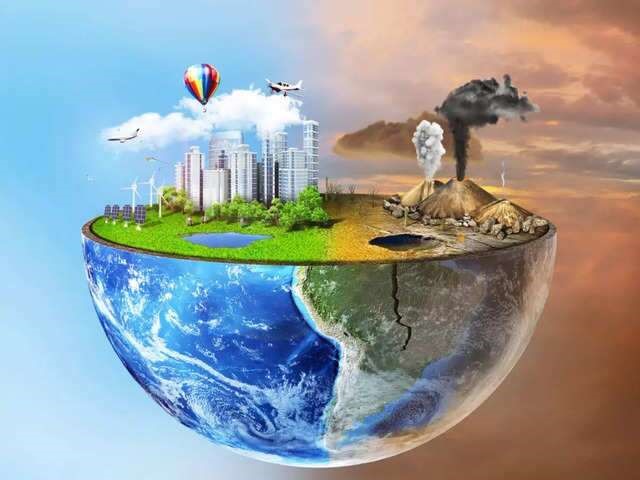Description

Disclaimer: Copyright infringement not intended.
Context:
A committee of 18 scientists have voted down a proposal to declare the start of the Anthropocene, or the “Human Epoch”, in geologic time.
Details:
A timeline of Planet Earth
- Geoscientists, or scientists who study the Earth, use the geologic time scale (GTS) to measure the history of the planet.
- The GTS (since the formation of Earth, roughly 4.54 billion years ago) is divided, in descending order of duration, into aeons, eras, periods, epochs, and ages.

- The GTS is based on chronostratigraphic classification. Stratigraphy is a branch of geology that deals with the study of rock layers (or strata).
- Chronostratigraphy (“chrono”: relating to time) is an aspect of stratigraphy that deals with the relation between rock strata and the measurement of geological time.

- Chronostratigraphic units are not uniform — any two aeons, eras, periods, epochs, and ages do not encompass the same length of time (like days or minutes).
- Rather, transition from one to another is marked by events (often violent, such as mass extinctions) that shape the planet and its living conditions.
- Importantly, each interval of Earth time must have a clear, objective, universally applicable starting point.
- Currently, we are living in the Phanerozoic aeon, during the Cenozoic era, in the Quaternary period, the Holocene epoch, and the Meghalayan age.
The proposed ‘Human Epoch’
- The Holocene epoch (from the Greek “holos”, meaning ‘whole’, and “kainos”, meaning “new”) began some 11,700 years ago, at the end of the Last Glacial Period (LGP).
- During the LGP, up to 25% of the Earth’s land surface was covered by glaciers, the mean sea level was up to 400 feet lower, and the average temperature fell to 8 degree Celsius.
- The Holocene saw the warming of the Earth, which closely corresponded with the rise and proliferation of human beings. While Homo sapiens as a species had evolved well before the Holocene began, all of humanity’s recorded history falls in this epoch.
- Since the year 2000, when the Dutch meteorologist Paul Crutzen and American botanist Eugene Stoermer coined the term Anthropocene, the idea of a separate ‘human’ epoch (“Anthropo”: relating to humankind) has excited many geoscientists.
- Proponents of Anthropocene argue that humans have changed the Earth to such an extent that a new geological epoch has begun.
- The Anthropocene Working Group (AWG), a 37-member research group, began deliberations in 2009 to come up with a starting point for the epoch and, after years of deliberation, decided on the year 1952.
- The period after World War II is seen as the “Great Acceleration”, during which the human population skyrocketed, the burning of fossil fuels surged, the fallout of nuclear tests spread across the planet, the use of nitrogen-based fertilisers became rampant, and plastics became ubiquitous.

Rejection of the proposal
- The AWG submitted its proposal to the International Union of Geological Sciences (IUGS), the representative body of more than a million geoscientists from more than 120 countries and regions devoted to international cooperation in the field of geology, last fall.
- Starting February 2024, the proposal was taken up for a vote by the Subcommission on Quaternary Stratigraphy (SQS), a constituent body of the International Commission on Stratigraphy (ICS), the largest scientific organisation within the IUGS.
- The SQS voted 12 to 4 against the proposal, with two abstentions. The IUGS committee determined that adding an Anthropocene epoch — and terminating the Holocene — was not supported by the standards used to define epochs according to chronostratigraphy.
Criticism
- In 2015, the geologist Bill Ruddiman and others wrote in Science magazine: “Does it really make sense to define the start of a human-dominated era millennia after most forests in arable regions had been cut for agriculture?”
- Recently the ecologist and environmental scientist Erle C Ellis, a former member of the AWG, wrote for The Conversation: “By tying the start of the human age to such a recent and devastating event — [such as] nuclear fallout — this proposal risked sowing confusion about the deep history of how humans are transforming the Earth, from climate change and biodiversity losses to pollution by plastics and tropical deforestation.”
- The boundaries between epochs typically tend to represent truly massive geological change. Our last boundary, between the Holocene and the Pleistocene, was almost one-third of this planet being covered by ice.
- Again, GTS is based on records in solid rocks, not sediments like the ones in Crawford Lake, Ontario, Canada, which AWG’s proposal had selected as the physical site which most clearly showed a definitive break between the Holocene and the Anthropocene.
.jpg)
Long live the Anthropocene
- It is important to note that the SQS vote was against the limited definition of the Anthropocene epoch, as proposed by the AWG. It was not a referendum on whether or not humans have had a lasting impact on the planet. Evidence for that is already past the point of being undeniable, and is mounting.
- Scientists have long proposed that the Anthropocene should not be seen as a new epoch but rather as an “event”. Events, in the language of geology, are looser terms which do not appear on the official GTS, and thus need no committees to approve their start dates.
- Nonetheless, many of the planet’s most significant happenings have been deemed as events — from mass extinctions such as the one that wiped out dinosaurs to the rapid expansion of biodiversity that filled the sky with oxygen 2.1-2.4 billion years ago.
|
PRACTICE QUESTION
Paul J. Crutzen, who often used the term 'Anthropocene' and who won the Nobel Prize for Chemistry in the year 1995, was a citizen of:
- Netherlands
- Germany
- France
- Poland
Answer A
|


















